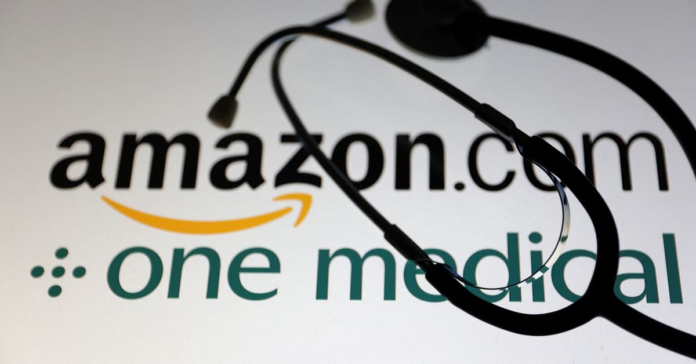A stethoscope is placed on displayed Amazon.com and One Medical logos in this illustration taken July 26, 2022. REUTERS/Dado Ruvic/Illustration Acquire Licensing Rights
NEW YORK, Nov 8 (Reuters Breakingviews) – Amazon.com (AMZN.O) is widening its costly healthcare experiment. The $1.5 trillion technology giant slashed membership prices for its U.S. doctors’ practice, One Medical, to $99 a year for Prime members. That may result in more happy users, but it’s unlikely to provide much benefit for the company.
One Medical’s value proposition is simple: In exchange for membership dues, which come on top of normal insurance charges for services, customers receive better care, including same-day appointments in two dozen metro areas. That’s proved popular, attracting 836,000 subscribers by the end of last year. Snag is, primary care tends to be a recipe for burning cash. The company, which Amazon purchased for $3.5 billion, incinerated $286 million in 2022, according to LSEG data.
Amazon’s move could be a simple matter of trying to lower prices, grow quickly, and enjoy the benefits of scale. Just look at Amazon Web Services, a business with about $90 billion of revenue annually and 30% operating margins. Digital products, however, have low marginal costs, meaning that selling to an additional customer can easily juice more profit out of an investment. Primary care runs on a lot of skilled labor. Adding customers tends to mean you need more doctors, or quality suffers. Even stripping out sales and marketing, complex administrative costs, and depreciation and amortization, One Medical’s heavily adjusted margin on providing care came in at only 18% of 2022 revenue. Cutting down membership fees, which represented 10% of revenue, could narrow that dramatically if costs grow in line with new customers.
There may be other benefits to Amazon. Drugstore chains have been buying up primary care companies in the hope of steering patients to their stores. Perhaps Amazon can do the same online. But success is not guaranteed. Walgreens Boots Alliance (WBA.O) reported a $566 million adjusted operating loss in its U.S. healthcare division for the 12 months ending in August.
Or perhaps offering better medical care helps Amazon hold on to its most valuable customers. After all, that’s the point of Prime, which had over 200 million members as of 2021. In exchange for a membership fee, customers get free and faster shipping of goods. That leads to bigger and more orders. Amazon has tacked on extra services over time, like video streaming, to make Prime more appealing.
Again, though, others have tried jumping into an unrelated business to aid subscriber retention. Telecom company AT&T’s experience(T.N) with buying media giant Time Warner suggests that realizing a meaningful benefit is hard. The businesses may be so disparate that managers end up destroying value. Cutting membership fees may just make Amazon’s healthcare experiment a bit more costly for itself.
Follow @rob_cyran on X
(The author is a Reuters Breakingviews columnist. The opinions expressed are their own.)
CONTEXT NEWS
Amazon.com said on Nov. 8 it had cut the price of membership in its primary care practice, One Medical, to $9 a month for subscribers to its Prime service, or $99 a year. Prime members can add up to five additional memberships to the same plan at $6 a person.
Amazon agreed to buy One Medical in July 2022, paying $3.5 billion net of cash acquired. The primary care provider had 836,000 members at the end of last year, with practices in two dozen metropolitan areas.
Prime is Amazon’s loyalty program. It had over 200 million members worldwide as of April 2021.
Amazon previously cut One Medical’s membership price in February, from $199 to $144 for Prime members.
Editing by Jonathan Guilford, Sharon Lam and Aditya Sriwatsav
Our Standards: The Thomson Reuters Trust Principles.
Opinions expressed are those of the author. They do not reflect the views of Reuters News, which, under the Trust Principles, is committed to integrity, independence, and freedom from bias.




